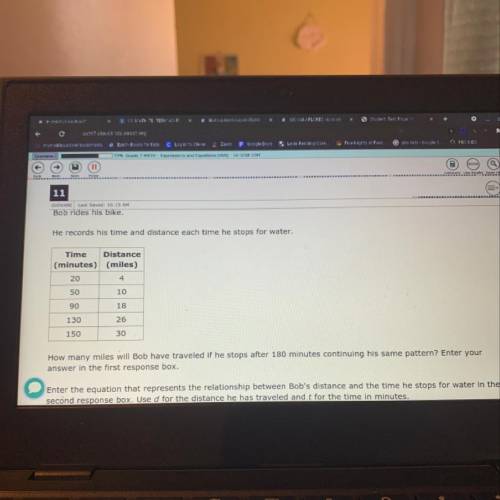
Mathematics, 30.04.2021 20:40 gabetrojanowski1936
Bob rides his bike.
He records his time and distance each time he stops for water.
4
Time Distance
(minutes) (miles)
20
50
10
90
18
130
26
150
30
How many miles will Bob have traveled if he stops after 180 minutes continuing his same pattern? Enter your
answer in the first response box.
Enter the equation that represents the relationship between Bob's distance and the time he stops for water in the
second response box. Use d for the distance he has traveled and t for the time in minutes.


Answers: 3


Another question on Mathematics

Mathematics, 21.06.2019 13:00
Acar traveling at 65 mph leaves 25 foot skid mark what is the ratio of the speed to length of skid mark (feet) in the simplest form
Answers: 1

Mathematics, 21.06.2019 21:00
Select the correct answer from each drop-down menu. a system of equations and its solution are given below. system a complete the sentences to explain what steps were followed to obtain the system of equations below. system b to get system b, the equation in system a was replaced by the sum of that equation and times the equation. the solution to system b the same as the solution to system a.]
Answers: 1

Mathematics, 21.06.2019 21:30
In a test for esp (extrasensory perception), the experimenter looks at cards that are hidden from the subject. each card contains either a star, a circle, a wave, a cross or a square.(five shapes) as the experimenter looks at each of 20 cards in turn, the subject names the shape on the card. when the esp study described above discovers a subject whose performance appears to be better than guessing, the study continues at greater length. the experimenter looks at many cards bearing one of five shapes (star, square, circle, wave, and cross) in an order determined by random numbers. the subject cannot see the experimenter as he looks at each card in turn, in order to avoid any possible nonverbal clues. the answers of a subject who does not have esp should be independent observations, each with probability 1/5 of success. we record 1000 attempts. which of the following assumptions must be met in order to solve this problem? it's reasonable to assume normality 0.8(1000), 0.2(1000)%30 approximately normal 0.8(1000), 0.2(1000)% 10 approximately normal srs it is reasonable to assume the total number of cards is over 10,000 it is reasonable to assume the total number of cards is over 1000
Answers: 1

Mathematics, 21.06.2019 21:40
Which statement is true about a number and its additive inverse? a. their product is always one. b. their sum is always one. c. they are always reciprocals of each other. d. their sum is always zero.
Answers: 1
You know the right answer?
Bob rides his bike.
He records his time and distance each time he stops for water.
4
T...
4
T...
Questions


Mathematics, 02.04.2020 01:53





Mathematics, 02.04.2020 01:53


Mathematics, 02.04.2020 01:53

Mathematics, 02.04.2020 01:53


History, 02.04.2020 01:53

English, 02.04.2020 01:53



Mathematics, 02.04.2020 01:53

English, 02.04.2020 01:53

Chemistry, 02.04.2020 01:53

History, 02.04.2020 01:53

Social Studies, 02.04.2020 01:53



